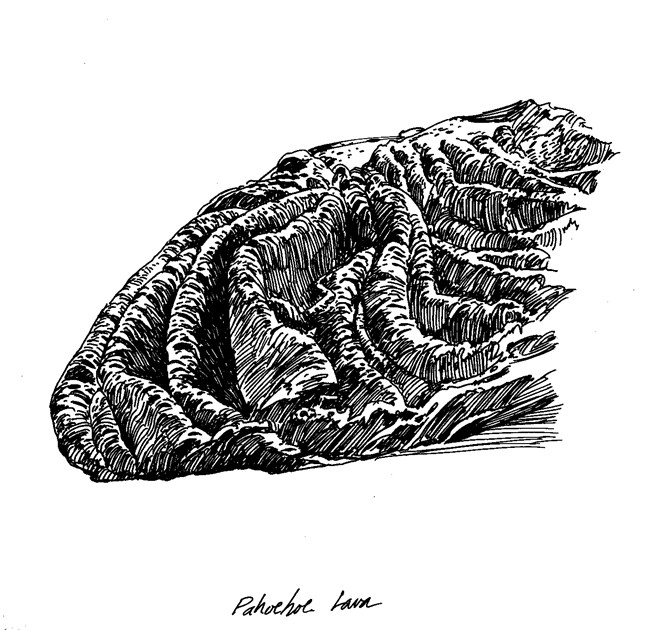
NPS Illustration SummaryWhere is the Volcano?Close your eyes and imagine a volcano. What do you see? A steep sided mountain that throws ash high into the air? Well, the volcanoes at Craters of the Moon are not like that at all! The eruptions at Craters of the Moon are called fissure eruptions, because the lava here came out of cracks in the ground. Craters of the Moon is on a weak spot in the earth's crust called the Great Rift. The Great Rift is 53 miles long. All along it there are volcanic cones, lava flows, and open cracks in the ground. Eight times in the past 15,000 years, melted rock has risen from deep within the earth and erupted along the Great Rift. The eruptions may begin again. Geologists believe there will be another eruption at Craters of the Moon within the next 1,000 years. Go with the FlowWhat were the eruptions like? First a crack opened in the ground. Then frothy magma (melted rock inside the earth) burst from the crack and sprayed hundreds of feet into the air. The crack began to clog up. The eruption continued as isolated fountains of red hot lava (melted rock on the earth's surface.) The foamy lava cooled as it fell. Bubbly cinders piled up around the vents. They formed hills called cinder cones. Gradually the eruption became less violent. The lava flowed quietly onto the surface from cracks in the ground. It spread out across the land. One lava flow at Craters of the Moon covers 100 square miles or over 12,000 football fields! All Black Rock is Not the SameYou will see a lot of black rock at Craters of the Moon. But if you look carefully you will notice several different kinds. As you walk across one of the cinder cones, listen to the crunch of the small rocks under your feet. Pick up a handful and look at them. They are very light and contain many air bubbles. These cinders erupted explosively and piled up around a volcanic vent. At the top of many of the cinder cones you will find a deep hole or crater. Lava erupted from these craters. Most of the rock, though, is solid and relatively smooth. This rock emerged from fissures and flowed across the ground like water. Some of the lava was very hot and thin. It flowed quickly and formed rock with a wavy surface. In some places the rock looks like coils of rope. This type of lava is called pahoehoe (pa-HOY-hoy). Cooler, thicker lava formed flows called a'a (AH-ah). A'a does not flow as fast as pahoehoe. It breaks up as it flows, forming a very rough, jagged surface. A'a means "rough on the feet" in Hawaiian, and you will see why if you try to walk across it! Strange FormationsYou will see many things at Craters of the Moon unlike anything you have seen before. There are caves in the lava flows called lava tubes. How did they get there? The surface of the liquid rock hardens first. The lava keeps flowing underneath this crust. When the eruption ends, the lava under the crust flows out, leaving behind an empty tube. There are miniature volcanoes called spatter cones. Thick, sticky lava burbles up along an opening in a fissure. Blobs of lava thrown into the air pile up around the crack. A steep walled cone forms. Some of the rock at Craters of the Moon is not black, but blue! A thin layer of glass formed on the surface of this rock as it was cooling. The glass is shiny and blue, which is how the lava flow got its name; the Blue Dragon Flow. In some places, steep towers of rock rise above the lava like castles called rafted blocks. These are pieces of a crater wall which was demolished by an eruption. Flowing lava then carried the pieces away like rafts on a river. Although there are not many trees at Craters of the Moon, in places you can see molds of tree trunks. The trees were surrounded by red hot lava. The rock hardened around them, leaving behind a mold of the trunk. Then the trunk burned away from the heat of the lava. All of these strange formations make Craters of the Moon a fascinating place to visit. Watch for them during your stay. |
Last updated: November 4, 2021
